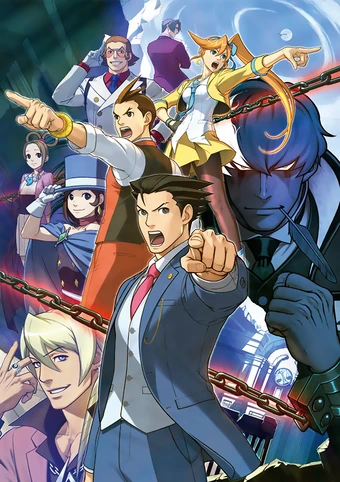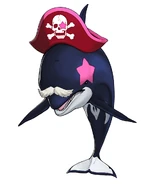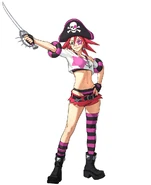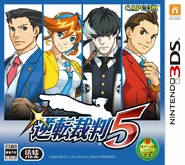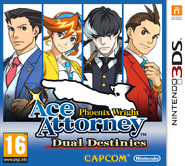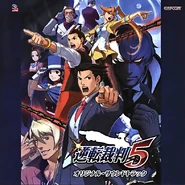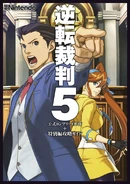Phoenix Wright: Ace Attorney - Dual Destinies, known in Japan as Gyakuten Saiban 5 (逆転裁判 5?, lit. "Turnabout Trial 5"), is an adventure video game published and developed by Capcom for the Nintendo 3DS. It is the seventh total game in the Ace Attorney series, excluding cross-overs, and the fifth installment of the main lineage. It was formally announced with a partial logo in Japan on January 29, 2012, alongside Gyakuten Saiban 123 HD as part of the Gyakuten Saiban 10th Anniversary Event.
It is the first in the series to be released on the Nintendo 3DS. Phoenix Wright returns as the main protagonist. The game was released in Japan on July 25, 2013. The game was released as a digital-only release in North America and Europe in October 24, 2013. The game was also only localized into English for the European release.
The development team is the team responsible for Ace Attorney Investigations: Miles Edgeworth and Gyakuten Kenji 2. Scenario director Takeshi Yamazaki replaced the role of series creator Shu Takumi, who reportedly was already busy with Professor Layton vs. Ace Attorney at the time. Takuro Fuse took over art duties for Kazuya Nuri.
Characters
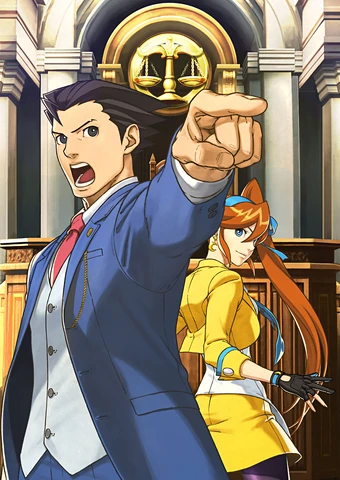
Promotional art.
Playable protagonists
- Phoenix Wright - The protagonist of Phoenix Wright: Ace Attorney, Justice For All and Trials and Tribulations. A previously disbarred defense attorney who has regained his badge. His magatama allows him to see Psyche-Locks around people, showing that they are hiding something from him.
- Apollo Justice - The protagonist of Apollo Justice: Ace Attorney and protégé working under Wright. Apollo has the ability to detect subtle, subconscious movements that witnesses make, aided by his bracelet.
- Athena Cykes - The new playable protagonist, partner character and newest addition to the Wright Anything Agency's defense team. She has a great drive to win, distinguishing her from Wright's original assistant Maya Fey. She can examine witnesses' emotions using a computer on her necklace, the "Mood Matrix".
New main characters
- Simon Blackquill - The game's rival prosecutor. A pale man with black eyeshadow and a feather in his mouth, he was ordered to stand in court despite technically serving a murder sentence; made quite clear with the large pair of handcuffs connected by a chain on his wrists. Blackquill also carries a hawk named Taka on his right shoulder. Blackquill uses psychological manipulation techniques. He also has his own interjection in court, which is "Silence!".
- Bobby Fulbright - A hot-blooded detective with the catchphrase "In justice we trust!". He has worked with Simon Blackquill many times and is paired up with him in court. The detective hopes to help the prosecutor redeem himself, and he seems completely oblivious to Blackquill's attempts to manipulate him. Bobby has such a strong sense of justice that he is compelled to intervene to help those in trouble, and he will even help defense attorneys if it will lead to a fair trial.
Returning characters
- Miles Edgeworth - A renowned prosecutor prodigy and the childhood friend and longtime rival of Phoenix Wright. He is also the protagonist of Ace Attorney Investigations: Miles Edgeworth and Gyakuten Kenji 2. By the time the game takes place, Edgeworth has become the Chief Prosecutor.
- The unnamed judge who has presided over most of the cases in Ace Attorney series.
- Trucy Wright - Phoenix Wright's adopted daughter and Apollo Justice's former investigative partner. A young magician from a well-known family of magicians, she is still working at the Wright Anything Agency and continues to aid the lawyers in their investigations.
- Klavier Gavin - Rival prosecutor to Justice in Apollo Justice: Ace Attorney and former lead vocalist and guitarist of the rock band "The Gavinners".
- Pearl Fey - A member of a Fey clan branch family and the younger cousin of Phoenix Wright's old assistant Maya Fey.
Story and episodes
Story
Phoenix Wright: Ace Attorney: Dual Destinies takes place roughly one year after Apollo Justice: Ace Attorney. By this time, Phoenix Wright has regained his attorney's badge. The plot has a darker theme than previous games in the series, in accordance with Wright's warning in the fourth game, "A dark time is coming for our legal system. We have to set it right". However, it has the same overall light tone of the other games in the series.
Episodes
It was stated by the development team that the game has roughly the same amount of content as Trials and Tribulations and would take 25-30 hours to complete.
- Turnabout Countdown - Phoenix Wright takes on Winston Payne's younger brother Gaspen, in the case of a high school girl named Juniper Woods, accused of planting a bomb to destroy one of the courtrooms at the District Court. Ted Tonate, a robotic member of the bomb disposal squad, is called in as a witness to the murder of Candice Arme amidst the destruction. This episode introduces Athena Cykes as Wright's co-counsel and the new "Mood Matrix" game mechanic. Phoenix is the playable lawyer for the case with Athena as co-counsel.
- The Monstrous Turnabout - The Wright Anything Agency is invited by Trucy Wright's friend Jinxie Tenma for a celebration at the Nine-Tails Vale village. The festivities are abruptly interrupted however, when the mayor of Nine-Tails Vale is found with a spear through his chest and Jinxie Tenma's father is arrested as the main suspect. This episode introduces the convict prosecutor Simon Blackquill and the justice-obsessed police detective Bobby Fulbright. It also features the return of Wright's adopted daughter Trucy Wright. Apollo Justice is the playable lawyer for the case with Athena as co-counsel.
- Turnabout Academy - The third case takes place at Themis Legal Academy during a culture festival. Apollo Justice and Klavier Gavin face off in a mock murder trial at the school, but when the murder becomes real, Athena Cykes steps up to the plate to represent Juniper Woods (who set up the mock trial and finds herself as the defendant in a real trial) against Simon Blackquill. This episode features the return of prosecutor Klavier Gavin who reprise the mock trial with Justice in order to gain more insight into the real murder. Athena is the playable main lawyer for the case with Apollo as co-counsel.
- The Cosmic Turnabout - Apollo's best friend Clay Terran turns up dead right after a spaceship that he was on blows up. Right before witness Candice Arme comes to the stand, the courtroom bombing from Turnabout Countdown occurs. Apollo decides to take a leave of absence to investigate the case on his own, so it is up to Phoenix Wright and Athena Cykes to defend Clay Terran's mentor, Solomon Starbuck.
- Turnabout For Tomorrow - A crucial piece of evidence appears implicating Athena Cykes on the murder of Clay Terran. This case might involve an incident from seven years prior to the start of the game.
- Turnabout Reclaimed - Downloadable extra case. This is Phoenix Wright's first case since regaining his attorney's badge (chronologically taking place between the game's second and third cases). In this case, he must defend a killer whale named Orla Shipley that has been charged with murder, as well as the orca's trainer, Sasha Buckler, of the murder of the owner of an aquarium.
Gameplay
The classic courtroom gameplay of the Ace Attorney series returns with some changes. The game world has transitioned into 3D with fully orchestral music, allowing for dynamic camera angles and more freedom in animations while retaining the 2D "touch" of the characters by taking measures to maintain the sense of speed and sharpness from the 2D games. The 3D transition also allows the player to look at rooms from different angles during investigations. In addition, the game features animated scenes by the anime studio Bones, similarly to Professor Layton vs. Phoenix Wright: Ace Attorney (which also has animated cutscenes from the same anime studio). The various sound effects common to the series have also been modified for the transition to the 3DS.
Dual Destinies also makes use of special powers possessed by the protagonists. Phoenix Wright's magatama and Apollo Justice's bracelet return from previous games, although unlike in Apollo Justice: Ace Attorney, the bracelet is mainly used in investigations rather than trials. Athena Cykes employs the "Mood Matrix" to examine the emotions of a witness and find contradictions between their emotional state and testimony. Another new gameplay mode is "revisualization" in which the player character reviews the known facts and builds up a train of thought to reach a conclusion. The player is presented with a series of facts of many kinds, such as items and evidence connected to the case, and must choose the correct one to advance the reasoning towards a final conclusion.
Changes to the formula
Dual Destinies includes several new features and modifications to existing features to make the fundamentals more accessible. A backlog function that allows players to review previous dialogue can be viewed at any time with a touchscreen button or the "Y" button. The fast-forward function, previously only available when going through repeated dialogue, can now be used to go through any dialogue. The game also shares some features with Professor Layton vs. Phoenix Wright: Ace Attorney, including a touchscreen button that takes the player to the save menu, a function previously accessible only through the "Start" button. Also like the crossover, multiple save files can be recorded into a single game copy, though in this case only two files can be made. Additionally, scenes being examined remain on the top screen, and the touchscreen functions as a trackpad to move a cursor around the scene (the circle pad can also be used).
The court record has also undergone an overhaul. In addition to the evidence and profiles, an investigation memo titled "Notes" lets players keep track of tasks that need to be fulfilled during investigation segments. All three are accessible as folder tabs at the top of the touchscreen, and they can be scrolled through with the shoulder buttons. The evidence and profile folders show the overview from the Nintendo DS games at the bottom of the screen, and a detailed view of a cursor-highlighted item appears above the menu, removing the need to select an item explicitly in order to view its basic information.
The penalty system is only used in trial segments of the game. When the penalty health bar depletes, rather than having to start over from a save point, the player has the option to continue where he or she failed, with the health bar fully restored. Moreover, if the player incurs three penalties or is forced to restart during a cross-examination, the player can press the "Consult" (X) button that appears, at which point the game indicates which segment of the testimony to examine.
Downloadable content
Free downloadable costumes were available in Japan until a month after the game's release. The costume pack includes the Old-School Suit, Phoenix Wright's old suit and appearance from the first three games; the Stylin' Street Clothes, a new casual outfit for Apollo Justice by character designer Kazuya Nuri; and the Themis Academy Uniform, a sailor fuku for Athena Cykes.
In addition to this are two downloadable extra cases, Turnabout Reclaimed and Quiz Turnabout Deduction. The first episode is also available for the American and European version of the game. The second episode was not however released in the West, due to its dependency on in-depth knowledge of Japanese culture.
Another downloadable costume is the old outfit Wright had worn during Turnabout Memories. The outfit is a reward for completing the extra quiz DLC. In the English version, this outfit will be unlocked upon the player completing the DLC case, Turnabout Reclaimed.
Development
Dual Destinies was produced by Motohide Eshiro and directed by Takeshi Yamazaki and Yasuhiro Seto, with music by Noriyuki Iwadare. Series creator Shu Takumi had no involvement in the title due to him focusing on the development of Professor Layton vs. Phoenix Wright: Ace Attorney at the time. The game was first announced in May 2007, a month after the release of the previous Ace Attorney game In January 2012, almost five years after the game's original announcement, Capcom revealed the game's logotype during the celebration of the series' tenth anniversary. In September 2012, it was revealed that the game would be released on the Nintendo 3DS, and that a demo would be available at Tokyo Game Show 2012. The game was developed using Capcom's game engine MT Framework Mobile.
When development began in 2011, only a few core staff members were working on the game, forming a skeleton team. At this time, Yamazaki said that the player should be able to use emotions and analytical psychology to reach the truth, in addition to using evidence: he thought that previous Ace Attorney games had only focused on evidence versus statements, and wanted to introduce a third element. Natsuki Ikawa, one of the game designers, read books on psychology and talked to the other staff members about what to do. She wrote down several ideas for how to handle it, including goggles that show the witness's personality as a specter, or a large computer that analyzes brain waves and heart rates, and showed them to Yamazaki, who would say "that's a pretty nifty idea" but still reject them; this contradiction between what he said and what he felt made Ikawa realize the basic concept for the mood matrix system, which was revised through feedback from everyone on the team and was implemented in the game. Another game designer, Yoriki Daigo, worked on several new features, including making the player able to move between locations freely and designing the revisualization system. Because the game was built from the ground up, the user interface for investigation sections was overhauled completely to be more visually appealing. The developers tried to keep the game simple, keeping it in line with Takumi's original vision of a game simple enough for his mother to play.
Sound effects from previous games, such as that of the judge's gavel, were remade for Dual Destinies: Toshihiko Horiyama, the game's sound director, re-imagined the original "crisp and dry" gavel effect as one where the initial sound of the gavel peaks early, leading into the richer sound of the gavel's core. He went through a similar process for all the effects, trying to both preserve the original sounds and revitalize them. After Horiyama came up with a sound concept, the game's sound designer, Amagishi, created the sound based on it. Because of the improved hardware capabilities of the Nintendo 3DS compared to the Nintendo DS, the development team was able to use unprocessed sounds of real instruments at some points in the music, such as in the title track, which features Iwadare playing the trombone. A feature was implemented where the game detects whether headphones are plugged into the Nintendo 3DS, and it adjusts the audio output to be optimal for the player's current setup. While Capcom staff provided all voice acting in previous Ace Attorney games, Dual Destinies instead used professional voice actors, with some smaller roles being handled by Capcom staff. Only the cutscenes are fully voiced; this was a deliberate choice, as the developers wanted to give the player the freedom to read dialogue in whatever kind of voice they want in their head. Eshiro also said that full voice acting would ruin the game's pacing and tempo.
Yamazaki focused on the game's scenario, while Seto worked as his "backup", ensuring that the development staff is all on the same page and that things go smoothly. According to Seto, Yamazaki was the person who had the most influence on the game, but his ideas sometimes clashed with Eshiro's, as Eshiro had to view the game as a product and give feedback based on that; the staff then had to create a compromise that both Yamazaki and Eshiro could accept. This led to long discussions, and eventually Seto had to make final decisions on what to do, which he called "no small task"; some big decisions took days to make.
Writing
Due to Dual Destinies being made long after the previous main game in the series, the developers felt that they needed it to make a big impact; they knew from the start that they wanted Phoenix Wright to return as the game's main character and as an attorney, since they had hinted at it at the end of the previous game. Additionally, they wanted to retain Apollo Justice as an important character, and not steal the spotlight from him, as he had already been established as a new main character. Feeling that Apollo's story had not been explored enough in the previous game, they focused on developing his character further in Dual Destinies, and added the character Athena Cykes as his junior. Yamazaki created Athena to be an active partner for Phoenix, rather than a "supporter in the background". The development team had problems with figuring out how to make the impact they wanted with the game with both Phoenix and Apollo, until they decided on the story concept of Phoenix and Apollo working to revive a collapsed trial system. From the start, Yamazaki knew that he wanted all three player characters to have their own motivations and purposes, which would play out throughout the game. At one point, he considered having five lawyers in the game, because of it being the fifth game in the series; he later called this idea crazy and overly ambitious, and felt that they had "dodged a bullet" by not using it.
The development team intended to continue the story of the previous game in the series in every way with Dual Destinies. They focused on an overarching story and plot twists, and on characters' motives and how they get involved in the story, but not directly on the characters themselves. When deciding which characters to bring back from previous games, they did not want to bring back anyone only for the sake of bringing them back, instead intending for everyone to have important roles in the story. They considered some characters to "come in sets", such as Apollo and Trucy, which affected which characters to bring back. Miles Edgeworth was brought back as the developers felt that Phoenix needed a character to play off of. Yamazaki said it was difficult to create the new rival character Simon Blackquill, as he had to be at least as unique and memorable as the ones in previous Ace Attorney titles. He came up with the idea that Blackquill would be a convict, thus being the "most criminal prosecutor yet". Blackquill's intelligence and use of psychological manipulation turned out to make trials challenging to write, as Yamazaki kept writing himself into a corner, with it being difficult to come up with a way for the protagonist to win. Yamazaki went through several ideas when brainstorming ways for Blackquill to be seen as a difficult opponent, such as making him immortal and two hundred years old, or "super-rich" and able to buy off any witness; these ideas were scrapped due to not fitting into the Ace Attorney series.
When writing the cases, Yamazaki would usually come up with the twist of the case first; he would think of something shocking or a surprising event, as well as the setting and set-up of the episode. He would then figure out how it could logically have happened, which he said was the most compelling method, story-wise; if it were done in the other direction – starting with how the case would work logically and then adding a twist - he found that it would not "ring true". He found that coming up with ways of resolving these mysteries was very difficult compared to coming up with the set-up. He worked towards including story developments that would "keep [the player] guessing", and puzzles that "appeal to their curiousity". He tried to create scenarios that make the player interested, which is how the bombing in the first episode and how the second episode's murderer appears to be a mythical creature. Among scrapped ideas for the episodes were a case of an "ethereal murder" where the suspect remembers killing someone but there is no body and no evidence of it even happening, and a case where a doll has been killed. He noted that these ideas, while having an impact and sounding interesting, were unrealistic and would not work. Yamazaki took inspirations from several different kinds of stories, including books, movies and television; the second episode in particular was inspired by the works of the author Natsuhiko Kyogoku.
The development team included a scripting team, who inserted pre-programmed scripts into the dialogue, a process referred to as scripting: these scripts could be used to change characters' animations, stop the text in the middle of a sentence, automatically proceed to the next text box, and pan the camera. The staff had to envision how scenes would look, and used these scripts to create a flow of character animations and add dramatic tension, such as adding a pause after a character sighs to increase the dramatic effect.
The downloadable episode Turnabout Reclaimed was written by the game designer Yuki Nakamura, with the concept of "lighthearted fun" to set it apart from the main game. The first thing she decided on was to feature an orca, and have the story take place in an aquarium; it took her several tries to decide on the rest of the story. One of the scrapped ideas involved the orca stealing treasures from the aquarium and attacking people by the shore during its escape to the sea, with the episode's mystery involving the reason for the orca's behavior. The opening for this draft would have involved guards and detective Fulbright vaguely referring to someone escaping, with the intention that the player would think they are talking about Blackquill, before it is revealed to be the orca.
Visuals and character design
Dual Destinies was the first game in the main series to be developed for the Nintendo 3DS; this move from the Nintendo DS to the Nintendo 3DS was the most difficult part of the development, with the development team being unsure of whether to use 2D graphics like with previous games or to use 3D models. Eventually they decided to use 3D graphics, because of the stereoscopic 3D effect being a selling point for the Nintendo 3DS system. Because of the move to 3D, the in-house artist Takuro Fuse was in charge of the art direction, rather than the series regular Tatsuro Iwamoto, so that they could have meetings about the art more often. This was Fuse's first work on the main series, so he initially had problems with making character designs that fit the series, and had to get a lot of feedback from Eshiro. According to Eshiro and Yamazaki, they put effort into the graphics, wanting to ensure that Dual Destinies' graphics looked better than those of Professor Layton vs. Phoenix Wright: Ace Attorney.
The first thing Fuse and his art team had to do was figuring out how to create 3D models that preserve the look and feel of the previous games' 2D sprites, even when viewed in stereoscopic 3D. Some of the artists on the team created a concept trailer for how the game's visuals would work, featuring a 3D model of Phoenix. Looking back at it, Fuse called the model "cringe-worthy", but it was able to be used as a base. Everyone on the development team gave feedback on the model, and it was continuously refined until everyone was satisfied with its look; this process alone took six months. The art team also wanted to preserve the "lively" style of animation used in the 2D sprites. To do this, they used "various tricks" such as using different character models for different angles. They also took advantage of the increased capabilities of the Nintendo 3DS hardware, and added camera movements and connecting animations to give the character animation further fluidity.
Fuse found Athena difficult to design, due to her being both an assistant to Phoenix and Apollo, and a strong-willed attorney who wants to prove her capabilities in court. He designed her hairstyle based on how she would be standing on the left of Phoenix or Apollo when assisting them, making sure that it looked good from that perspective. He also created the hairstyle to be able to convey Athena's enthusiasm and energy through its movements. He gave Athena the little gadget named Widget, that hangs around her neck, to visually represent the mood matrix. As they wanted other characters to be able to see the mood matrix, it was decided to make Widget project the mood matrix as a hologram. The mood matrix itself, which needed to represent people's mental state visually, was a challenge for the art team. They eventually decided to use the vastness of outer space and the Earth in the design, and ended up using a portable planetarium as the base motif. This also influenced the mood matrix background music, which Fuse described as having an "outer space feel".
When designing Simon Blackquill, the new rival prosecutor character, Fuse initially intended to make him different from all previous Ace Attorney prosecutors and focusing almost entirely on the convict aspect of Blackquill, making him look like a "total criminal". At this point in development, Blackquill was intended to be the character who could analyze emotions based on voices, so he was given a headgear to wear. Next, Fuse put more focus on the prosecutor aspect, but ended up with a design that he described as "just another prosecutor"; he realized that the prosecutor and convict aspects were opposites, with one decreasing as the other increases.
The black-and-white stripes on the prisoner's uniform in the first design reminded Fuse of the Forty-seven Ronin, who wore black and white; this led him to incorporate traditional Japanese clothing into the design. He called this the key to solving the problem, but still had further issues with the design: if he made the outfit too Japanese, Blackquill would not look like an Ace Attorney prosecutor, and he thought it would be strange if he gave him a katana like an actual ronin, since Blackquill is a convict, and even average citizens are not legally allowed to carry swords. He realized that he could use a combination of Japanese black-and-white clothes and prosecutorial Western clothes found in the Meiji era, when Japan was Westernized. As they needed the character to look "sharp and stylish in Western clothing", the only direct indication of him being a convict in the end was his shackles. His messy ponytail was also used to convey a feeling of "long incarceration", as well as evoke the image of a ronin. Blackquill's hawk, Taka, was initially just meant as a part of the Japanese elements of the design, being reminiscent of Japanese falconers. Taka's role was eventually extended to bringing documents and evidence to Blackquill, highlighting how Blackquill's movements are hindered by his shackles. Fuse described the final design as looking like a "Meiji Restoration-era fighter".
Cutscenes
Dual Destinies features animated cutscenes produced by the animation studio Bones, which were directed by Seto at Capcom and Kenji Nagasaki at Bones. The scripts for these were drafted by Yamazaki, and included characters' lines as well as the general events and backgrounds for each scene. After the scripts were written, they were sent to Nagasaki, who drew storyboards for the scenes. When boarding the sequences, he added suggestions for details and nuances; for instance, in the script for one scene, Athena was going to trip and fall over, while Nagasaki suggested and boarded her tumbling down stairs, and added a guard character for her to interact with at the end of the scene to emphasize how painful the fall had been. After finalizing the scene, the team at Bones worked on the background art; while the courtrooms and defendant lobbies are shown in-game, the courthouse's stairway and main hall had not been shown before, and had to be designed specifically for the cutscenes.
After the different components of a scene were finished, the team at Bones created its layout art; this included things such as determining the camera position throughout the scene and how movements will be done. The developers wanted to focus on how the characters' faces were drawn and animated, and make sure that the characters matched their respective in-game 3D models, so Fuse gave detailed feedback on the layouts, and drew over them in red to indicate what he wanted to be changed. These changes included corrections to off-model drawings, facial expressions, body postures, and character acting. Once the layouts had been approved, the animators drew the key animation, after which the in-between frames were drawn. Once the animated footage was completed, it was put together and rendered in stereoscopic 3D. Voice acting, music, sound effects, sound leveling and remixing was then done, and added to the cutscene.
Localization
Capcom announced a localization for the North American and European market in September 2012; at the time, they had planned a localization for about two years. Capcom USA's senior vice president, Christian Svensson, stated that the sales forecasts for Dual Destinies were high compared to how well the franchise has performed commercially in the past, which was necessary to get it released in the West.
The localization was directed by Janet Hsu, a series regular who previously worked on Ace Attorney as the localization lead and lead translator. As the localization team wanted to work closer with the developers on Dual Destinies than they had on previous games, the localization work was incorporated into the overall development of the game. This gave them a larger degree of insight into the developers' intentions with the game, helping them with localizing the game more faithfully. The localizers also had more control over the pre-programmed dialogue scripts in Dual Destinies than they had in any of the previous Ace Attorney games: they were able to use an internally developed tool to transfer the scripts from the Japanese dialogue to the English one; the development staff would put the scripts in the general area they belonged in for each sentence, after which Hsu would adjust the placement to increase the dramatic impact, for instance by having a dramatic pause and finger-pointing animation occur at a specific word. Due to Japanese word order being different from English, Hsu sometimes had to add words to "push" a big reveal into the second half of the sentence or rearrange the order facts were revealed in, to make revelations line up with dramatic animations or camera zooms.
Hsu described the localization work as a balancing act, and said that continuity and consistency was very important. To avoid situations where a small detail in one game is changed in localization, and then comes back as a major point in a sequel, Hsu avoided changing things unless necessary, such as when something in the original would not be understood by the target audience. One thing the localization team had to keep in mind was keeping the writing in-character: when substituting a Japanese joke with an English one, they had to consider whether it would be something that character would say, not just whether it is funny. They also worked towards having puns and references be appropriate for the dialogue, so that the dialogue still makes sense to players who do not get the reference or pun.
Characterization and naming
One of the first major decisions was how to localize character names. Hsu said that if character names sound too foreign and do not have any unconscious associations attached, rooted in the player's culture and language, they just come across as a "jumble of sounds" to the player, serving no purpose; she felt that the localized names, like the originals, should strive to convey certain images and feelings to the player. She said that this was particularly important in Ace Attorney, due to how integral each name is to its respective character. Hsu and the translators brainstormed ideas, and eliminated suggestions until they had a final name for each character. These names are puns or have meanings: Athena Cykes' first name is a continuation of the series tradition of naming protagonists after mythological creatures or gods. The reason for spelling "Cykes" with a C instead of using the more common spelling "Sykes" came from how "Sykes" was considered too similar to the previous character Ema Skye's name, and how the shape of the letter C connects to the crescent moon motifs in the mood matrix, her glove and her earring. Widget was localized to use male pronouns because of his Japanese name, Monita (モニ太?), which uses the kanji character "ta" (太?) from the name Tarou (太郎?), and which is often used to create "generic-sounding little boy’s name out of a noun". Widget's English name was chosen to sound little and cute, similarly to the Japanese version's use of "ta" (太?) rather than the usual way of writing "Monita" with the katakana character "ta" (タ?).
While Simon Blackquill speaks in an old-fashioned and "rough" way in the Japanese version, matching what a ronin would be expected to sound like, Hsu said that this cultural shorthand of a ronin character did not exist in the West to build his character upon, so his characterization had to be rendered in a different way to be more accessible to Western players. Hsu and the translators had the same problem with this as Fuse had when balancing the prosecutor and convict aspects of the character, but eventually leaned more towards the prosecutor side, and made him speak Victorian English. They felt that this made more sense than portraying him as a cursing delinquent due to how his high intelligence, and his Victorian-era clothes, due to their different cultural connotations in the West compared to in Japan.
In the localization, they labeled him a samurai rather than a ronin – which is a subset of samurai – due to samurai being more recognizable and readily understood for Western players. They still portrayed him as a "rude jerk", as they were able to preserve that aspect through word choice: Hsu said that both Japanese and English from the Victorian era could be verbose, making the two styles blend naturally during Blackquill's "samurai" sword metaphors. Blackquill's localized name was developed together with his manner of speech, and like with previous prosecutor characters, it was chosen to not be an "overt pun", but rather a name with a double meaning that describes him. His surname comes from how he wears a samurai battle surcoat: these coats commonly feature the wearer's family crest. The crest on Blackquill's coat features a black-and-white feather, so his name was based on the color ("black") and the feather ("quill"). It was also made in reference to the character John Blackthorne from the novel Shōgun. The name was intended to sound like a "Victorian villain", to match his localized characterization and manner of speech.
Visual changes and dubbing
Localizing backgrounds was more difficult than it had been in previous games: while the earlier games used 2D illustrations as backgrounds, which could be changed, Dual Destinies uses 3D models, hindering the localization team from changing the shape of objects without risking encountering bugs. Because of this, Hsu described some objects as not feeling "right"; the most prominent type of object affected by this was signs with vertical text, which she said did not feel as natural in English as in Japanese. Some aspects of the user interface had to be modified as part of the localization: for instance, some text had to be moved around on the save file screen because of some words being longer in English than in Japanese, and a smaller font was chosen for the investigation notes to allow for multiple lines of text. For the dialogue box, a thin condensed font was chosen, and the box itself was elongated, to make room for as much text as in previous games. They only used two lines of text for it, both to look visually pleasing and to avoid hiding important detail behind a taller box.
For the cutscenes, the localization team had to take into account that the animation had been done to the Japanese lines, so they had to make sure that the English script matched the already set lip flaps and timing. Because the Japanese voice acting had not yet been recorded when Hsu worked on the English dub script, she had to use her imagination a lot to guess what the Japanese voice acting would be like based on the script; this was made easier due to her familiarity with "standard anime conventions" from watching a lot of anime. For some dialogue, she wrote alternative lines, as the footage had not yet been finished, and the script could be interpreted in different ways: in one scene, where Phoenix speaks on the phone, Hsu had him following the line "It's for this very reason I returned" with either "Time to bring it to an end" or "To put an end to it all"; she used the former because of how there was a dramatic pause between the two lines.
The English dub was recorded at Cup of Tea Productions, and was directed by Sam Riegel, who also voiced Phoenix, having previously voiced the role in Ultimate Marvel vs. Capcom 3. Hsu was present for the recording, as she knew the story and was the translator of the scripts, and thus could explain what was happening in each scene and what the motivations behind the lines were, as well as how she wanted the voice actors to deliver certain lines. Because Horiyama had attended the Japanese voice recording sessions, he was also present, so he could give advice about things that sounded too different from the Japanese version, and give consultation about technical issues within the game. The voice actors took turns recording their lines to near-final versions of the cutscenes, so they could match the characters' lip flaps. In addition to the voice acting, some sound effects had to be localized, due to sound being used differently in Japanese and Western films, resulting in different things sounding natural; one such case was the opening cutscene for the fourth episode. Due to the English voice acting sometimes becoming unintelligible when sound effects or music was played on top, the localization team had to lower the volume of the music at some points, move the sound backwards or forwards slightly, or raise the volume of certain consonants; the largest such issue was the voice clip for the "Objection!" interjection, where the "b" consonant initially was drowned by the sound effect.
Music
The music used in Dual Destinies is almost entirely from the Gyakuten Saiban 5 Original Soundtrack. That is, almost every music track used in the game is either original or a new version of a track from a previous game. Even "Suspense", which survived unaltered through all six games in the series prior to Dual Destinies, was replaced by a "Suspense 2013". However, Dual Destinies uses "Guilty Love" and "Surging Eyes" from Apollo Justice: Ace Attorney's soundtrack.
Trivia
- Capcom USA’s Senior Vice-President, Christian Svensson, cited difficulties with ensuring retail support for physical releases of the Ace Attorney games as the reason for the game's download-only release in the West.
- Excluding the European box art for the original game (which only has Phoenix Wright on it), Phoenix Wright: Ace Attorney: Dual Destinies is the first game in the Ace Attorney series to have characters with voiced speech bubbles in-game featured on the front cover of the box art.
- Dual Destinies is also the first game in the series to have these distinctions:
- It has no female culprits.
- It feature more than five cases (if the DLC case is included).
- It has the first case take more than one day to resolve.
- It has neither of the previous English and Japanese lead directors (Ben Judd and Shu Takumi, respectively) involved in production in any way.
- It has none of the victims encountered by the player prior to their deaths.
- It is the first game to receive a ESRB rating of M, compared to the T rating used in past titles (however, the ACB retained the PG rating it had applied to the previous titles).
- It does not feature Dick Gumshoe or Winston Payne, although the latter is at least mentioned in passing.
- Yumihiko Ichiyanagi, a character from the Japan-exclusive Gyakuten Kenji 2 (released in 2011), wears a blue Themis Legal Academy uniform underneath his coat, though this wasn't known until the Gyakuten Saiban 5 Official Complete Guidebook, which states that he studied there, and that the blue uniform he wears was previously the uniform for students taking the prosecutor course until it was changed in later years to the red uniform seen in "Turnabout Academy".


